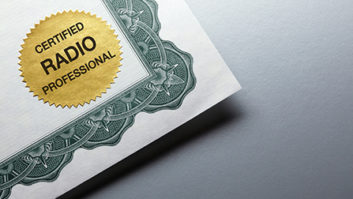Or, ‘Four Rules for Auction Happiness From One Who Has Been There’
Well, here we go again.
Assuming the schedule holds, Nov. 1, 2005 marks the beginning of the second Great Spectrum Rush, as FM Auction No. 62 might be called.
As an unsuccessful – and still somewhat bewildered – participant in Auction 37, (see “Musings of an Auction Loser” in the Jan. 5 issue), I feel reasonably well informed on this subject and so offer some thoughts for prospective bidders.
Have brass
First of all, if this upcoming auction is even remotely similar to the last one, be prepared to throw bags o’ cash at whichever permit catches your fancy. Remember those little steel balls Captain Queeg nervously rolled around in his hand in “The Caine Mutiny”? Not even close to what you’ll need in an FCC auction, if you know what I mean. Think brass and think big.
Auction 37 generated around $175 million; so before you get in real deep, take some time now to evaluate exactly what it is that’s on sale here.
And while you’re at it, save yourself some money and do the initial fact finding yourself. You do not have to pay expensive consultants or buy high-priced software to check out the basics. In Auction 37, a lot of people paid premium rates to have someone else research and then bid on permits, only to find out that, in most cases, the bidding got so nuts that they had to drop out.
So before investing cash up front on experts, ask yourself: Does anybody actually live in the city-grade contour of that big full-throttle Class C in Outlook, Mont.? Draw a 50-mile circle around Outlook on a map (which is about as far as you can move a Class C and still cover the city of license) and see if there is anywhere you could put a 1,600-foot stick and cover anything of significance.
Check the coordinates of the permit – available in Attachment A of the Auction Public Notice at www.fcc.gov/auctions – to see where the original applicant planned to locate the station. Some of these permits were just tossed out there, with little thought given to running them; still others have been moved around to accommodate other rulemakings. You might be surprised when you plot the proposed tower site on a map.
The FCC Table of Allotments Section 73.202 – available online at www.access.gpo.gov/nara/cfr/cfr-table-search.html#page1 – is also a resource to scope out the potential competition. There, you can find out what other allotments are in, or near, any of the 172 allotments being auctioned.
If you think you need to go to the next step of trying to figure out how to do a rulemaking to move three or four other guys in order to move Outlook to InClose, you can always hire that out. But remember, the money you spend on all that engineering and the filing fee (not to mention the time a rulemaking takes, usually measured in years, not months) should be factored into the amount you are willing to bid.
And, oh, by the way, if you win, you will, of course, still have to build that 100 kW blowtorch.
Get real
Second, forget about the various “bidding strategies” that you might be conjuring up in an effort to misdirect other bidders as to your actual intentions.
I tried a little of that in Auction 37, thinking – foolishly, it turned out – that I would fake out other bidders by “salting” my permit list with a few in which I had absolutely no interest. Then I could dance from round to round and from permit to permit, cleverly waiting for the moment to spring my completely unbeatable bid for Albany, Texas, on those unsophisticated dupes.
Right.
Turns out, I was so far down the food chain that even when I went all-in for one I really wanted ($100,000 for Albany!), the Deep Pockets just blasted past me. I could almost hear the yawns as my bid went from highest to lowest in a single mouse click.
So don’t worry too much about someone figuring out that you really, really, love Montana. From my experience, if they want the darn thing, they’re gonna get it, and damn the expense.
Take a deep breath
Third, don’t get caught up in the moment. This is kind of a reverse carpe diem thing. If you are bold enough to seize the day, you will have to pay for it on another day, and not too far in the future.
Pick your permits and the amount you want (and can afford) to pay, carefully. When the gavel falls and you are the lucky winner of one of these permits, you can be assured that the FCC cares not one nit about your ability to pay.
If the permit you cherish … just cannot live without … just GOTTA HAVE!!… gets bid up past your top price, walk away.
The easiest way to do this is to set your price before you start bidding. Do your homework. Decide what this business is worth, and bid accordingly. Because if you bid $1 million for Outlook, or Blackduck or whatever, God help you, you might actually get it … and then what? Well, you can withdraw your bid, but the FCC has made that a bit painful. There is a forfeiture formula, based on a couple of factors, but no matter the actual amount, who wants to pay for nothing? So, forget carpe diem and bid carefully.
Have hope
Fourth, take heart. Amidst the wads of cash being thrown around for truly questionable permits, a few folks did go home with bargains last time. Several permits with honest coverage went for under $100,000, and a few for less than $50,000.
In a time of million-dollar bungalows in the San Fernando Valley, that’s not too shabby: a business – as opposed to an 80-year-old live-in shoebox 50 feet from the Ventura Freeway – for under a hundred grand. In spite of my occasional cynicism, owning a radio station is a lot of fun – sandwiched, of course, in between the usual business crises from day to day – and it beats the heck out of selling shoes.
So there you are: four rules for auction happiness. If you are inclined, get out the checkbook and the atlas, and join in the fun on Nov. 1.
The important dates are on the FCC home page; and don’t forget the pre-auction seminar. If you plan to attend that, look me up; I’ll be the guy with the two little steel balls, looking kind of lost in the middle of all that brass.
Reach the author at [email protected].









